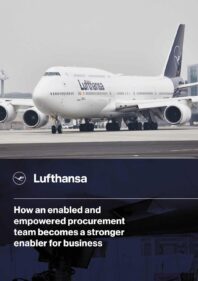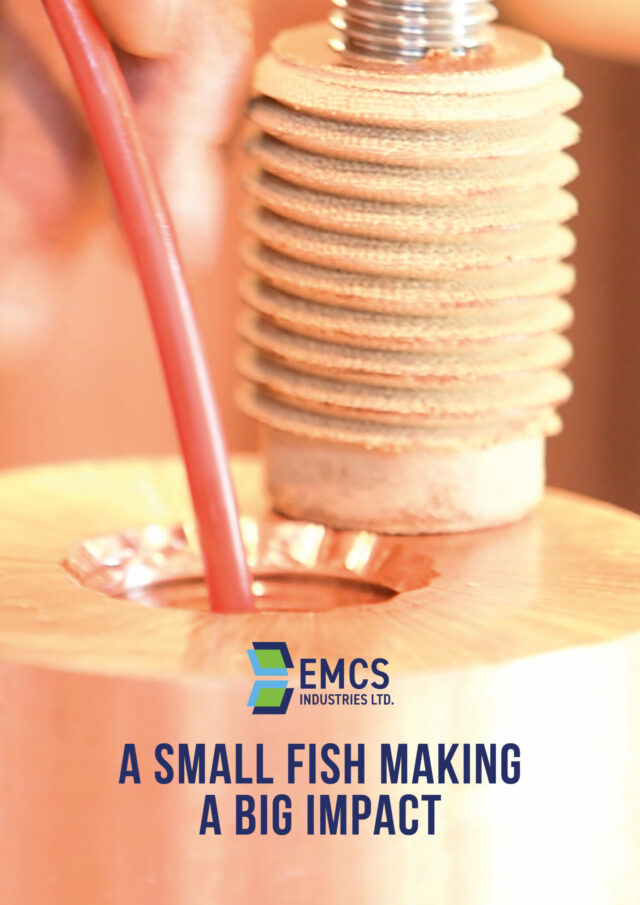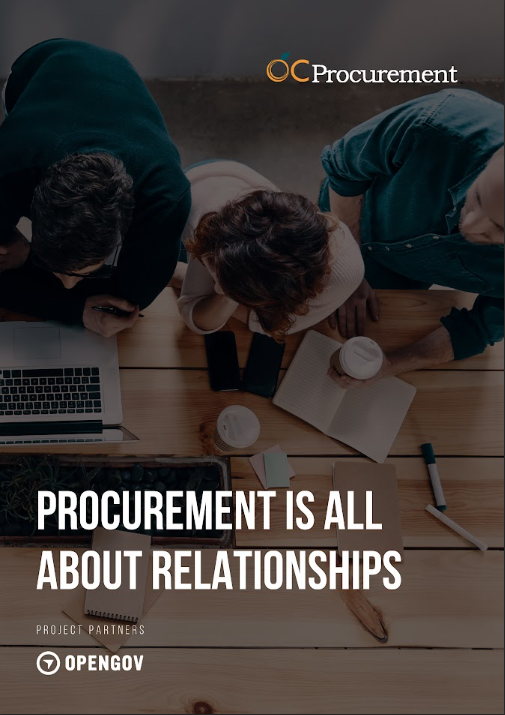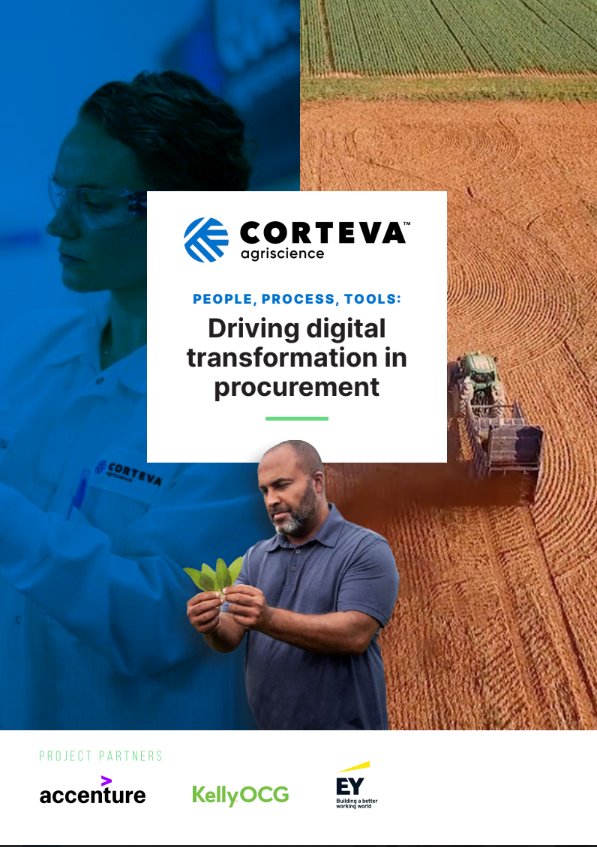Many people have a classical perception about procurement. To them procurement is an administrative function hidden away in the back office. Procurement is simply to get the right things for the right time in the right quantity. “This is just a starting point,” explains Angela Qu, Senior Vice President, Chief Procurement Officer at Lufthansa Group. “Procurement can provide more added value to the business, if we become much more strategic, and are able to bring valuable market information and alternative solutions to the decision table. Further, we should be able to facilitate collaboration with internal and external stakeholders, connecting the dots of the whole supply chain. Ultimately, procurement should drive supplier innovation and sustainability at the top of its agenda. Thus, we can support the company’s growth and become the key enabler of value chain creations.
However, there is a long way to go from where we stand today, even knowing where the final target is, as we head towards where we want to be in a 5-year horizon.”
Procurement vision 2025
Like many procurement professionals, Angela Qu had a very clear mission in mind as she started her tenure at Lufthansa Group: to create a better alignment on long-term objectives across the different procurement teams within the group, and to bring procurement to a much more strategic level. As part of this, she also looked at making the procurement contribution much more visible from a P&L context while also upscaling and skilling people across the group.

This mission started in April 2019 and she recounts that ‘day one’ proved to be one of the most significant. “I met my whole procurement leadership team and was asked by one of the colleagues: ‘What is your vision here? What do you want to achieve?’” Qu replied: “It’s not about what I want to achieve, but rather what we want to achieve. Let us work it out, together!”
Right after that first week, Qu organized a series of strategic workshops with her leadership team that consisted of the various heads of procurement from different airlines within the group. Collectively they defined their long-term goals of the procurement function (i.e. where they wanted to be in five years). Thus, a vision was born. Procurement Vision 2025 will see procurement become a key contributor to the overall growth of the company and the associated value creation.
The Vision is built on three pillars:
Strategic: foster next level strategic sourcing, supported by automated and digitalized processes and tools to procure products and services with best-in-class quality and cost
Professional: enhance competence and entrepreneurship amongst procurement staff; ensure a high-performance driven organization and create a professional image to internal and external stakeholders and suppliers
Sustainable: build partnerships with internal partners as well as suppliers; retain knowledge and talent while providing sustainable solutions to business units and include sustainability aspects into decision-making process
With these three key pillars in place, the team has identified their strengths and weaknesses in terms of current organization, structure, process, tools etc. Qu could then begin to launch short-term and long-term actions.
Enable and Empower the procurement teams to reach higher ambition of performance
In procurement, particularly in times of transformation, results speak louder than anything else. Qu recognizes this and she can point to some considerable successes that she has overseen in her time with the company. In 2019, Qu’s team achieved a significant growth in savings, representing almost a 50% increase on 2018; a testament to the work that Qu and her procurement team achieved in a short time. The key success factor was the launch of “Next Level Strategic Sourcing – NLSS”, which is the foundation of Vision 2025’s strategic pillar. The aim of NLSS is to enhance the plan-to-strategy process, with a standardized procurement methodology (using the “Kearney Purchasing Chessboard”) in a continuous improvement approach to generate sustainable value for all stakeholders.
It is a simple five-step approach:
1) Spend transparency: understand spend through data and market analysis
2) Benchmark: set benchmark, define gaps, analyze root causes and aim for innovation
3) Develop: define category strategy and action plans with product owners/ process owners/ demand organizations
4) Implement: execute strategy and improvement plan
5) Sustain: review, reflect, and prepare for continuous improvement
Along with rolling out NLSS across different categories, Qu also focused on strategic empowerment of group category managers. Qu notes that: “we empower our group category managers by letting them understand what they’re responsible for and what their mandates are. Empowerment means that they are truly aligned to the procurement vision and understand how they can play a key role in the transformation. In the end, the team has to deliver the requested results.”

On top of that, Qu looked at those “enablers”, including advanced tools, data analysis capabilities, functional trainings, cross-industry best practice sharing programs and working collaboratively with other partner functions to find the best solutions for the business. At the same time, Qu spent significant time building the large talent base “Spotlight on Talent for Procurement”, which is a group wide program, identifying talents and giving them insight regarding procurement as a function. She ran numerous dialogues and one-on-one talks with potential talents from other functions, explaining why procurement is a great place to be. Through those active communications, she was able to attract talents into her organization with new ideas and new ways of doing things.
“I am very proud to see that, through this journey, our own organization has transformed from a disparate procurement community to a more aligned and performance-driven procurement team! Together we became stronger as a function, as we can build upon our competences and knowledge from each other. Through our Next Level Strategic Sourcing processes, we have become a valued business partner rather than simply waiting there until we receive a request to negotiate,” says Qu.
COVID19 and crisis management
With key successes under her belt, the future looked bright for Angela Qu and procurement at Lufthansa at the beginning of 2020, with Qu and her team well on their way to another 30% saving increase compared to 2019. Qu was about to launch a supplier innovation campaign that would see Lufthansa work closely with its suppliers to redefine and reinvigorate the relationship model and to drive innovation and sustainability. Alas, 2020 saw the world gripped by the COVID-19 pandemic and companies have been forced to act fast in order to mitigate the impact as best as possible.
“It was a unique situation for me and my team,” affirms Qu. “Without much warning in advance, in early March the Group’s cash inflow suddenly dropped by 90%. This was a challenging time for my team and me. First of all, we were worried about the health and safety for ourselves and our loved ones. We also had to keep a functioning supply chain for on-going operations, such as Lufthansa Cargo who flew masks and medical equipment around the clock, and also the many rescue flights which the Lufthansa Group performed for our home countries. The most challenging part has been the 3rd pillar: sustain cash within our company in order to weather the storm.”
Looking back to the last few months, Qu speaks of the importance of acting fast, calmly, and professionally, particularly when dealing with supplier relationships. As Qu says, “the value of procurement has been particularly effective in knowing when to aggressively conserve cash to meet internal liquidity goals, and when to protect and support the most fragile parts of the supply chain in these turbulent times. Whatever we do has to be within the legal framework and based on mutual agreement with our service providers and suppliers”. Lufthansa Group has taken corporate responsibility especially seriously during this challenging time. A special approval process was established for small and mid-size enterprises, or private owned companies in urgent need, so that they received their payments on time.
In mid-July Lufthansa group received state-aid support. The procurement team has played a key role to mitigate insolvency risk. “It was essential to have a high degree of transparency,” she says. “It was important to look at all purchasing requisites and identify what is in the pipeline, and cancel purchase orders on time. We also lowered down the threshold of approval so that every external spend request went through a special controlling approval process. We worked extremely hard to ensure that our buyers were equipped to communicate the complexity of what was happening and to communicate with our suppliers in an open and transparent way. “I am grateful for those corporation partners and suppliers who have supported us with special contributions and prolonged payment terms during the past months. Those who demonstrated great willingness to support and collaborate with us in the difficult times will remain our strategic partners for the future,” says Qu.
Going Forward
Procurement has transformed significantly at Lufthansa, and the crisis has meant further transformation is afoot. As the pandemic continued, so did the impact on business continuity and Lufthansa had to look at its plans for the future – both long-term and short. Initial successes were crucial, but it was time for Qu and her teams to differentiate what crisis mode was and what the next phase was going to be. “We are okay, we managed our crisis well, but now we have to move into the next stage, which is the ReNew phase,” says Qu.
Facing the current challenges across the aviation industry, procurement teams in the Lufthansa Group are focusing on three topics: ensuring smooth operations; maintaining competitive cost base; and generating profits for each flight. Throughout the crisis time, Qu notes that she and her teams are changing their role from the traditional cost-cutting role into a true enabler of business. “We have to enable smooth operations, in a fast-changing environment, The flight plan is not stable, and we need to have a high degree of flexibility in our supply chain planning and commercial agreements. We have to ensure our cost base becomes even more competitive. We are looking at how we leave out complexity and how we as procurement can be true enablers to our internal partners. We need to help our requesting departments, which have very limited budgets to get the services and products they need.”
Qu reflects that the COVID-19 crisis has not been a distraction from those initial goals set in 2019, but instead has been a catalyzer and an accelerator. Whereas ‘Procurement as an Enabler’ was a key focus prior to 2020, it now becomes THE focus moving forward. “It will go hand in hand with our strategic business partnering,” she adds. “This will be our key focus in the near future and I believe we can truly enable the organization to grow again as we navigate and move beyond this crisis.
What makes a successful procurement organization?
Prior to COVID and indeed throughout, Qu and her team have achieved an incredible amount of success. Is there a secret to this success, a silver bullet that could guarantee success both now and in the future? Unfortunately, there is not, but Qu is keen to highlight there are things we can all do to ensure that whatever path we take, the road ahead remains a step in the right direction. “Procurement managers need to understand the company’s overall strategies and top priorities; we must align procurement strategy accordingly to support the business. Going forward, we must remain flexible, fast and responsive towards market changes, including better analytics skills, stronger forecasting visibilities on cash management and informed decision making which are the keys to achieving success. Ultimately, it all starts with proper communication towards our own team, our internal stakeholders and our supplier base. That will forever be crucial to being a true enabler and delivering true value to the business.”









